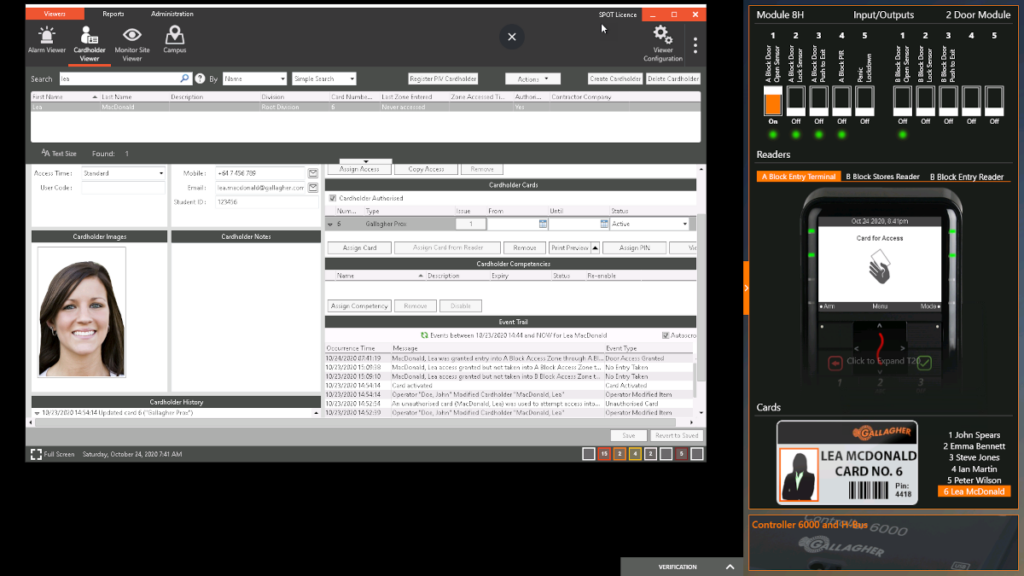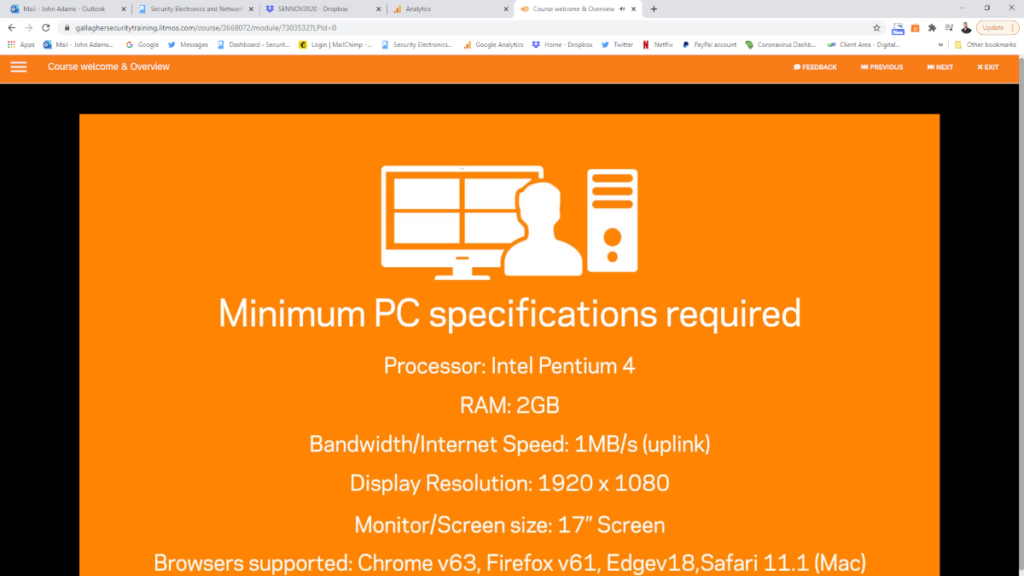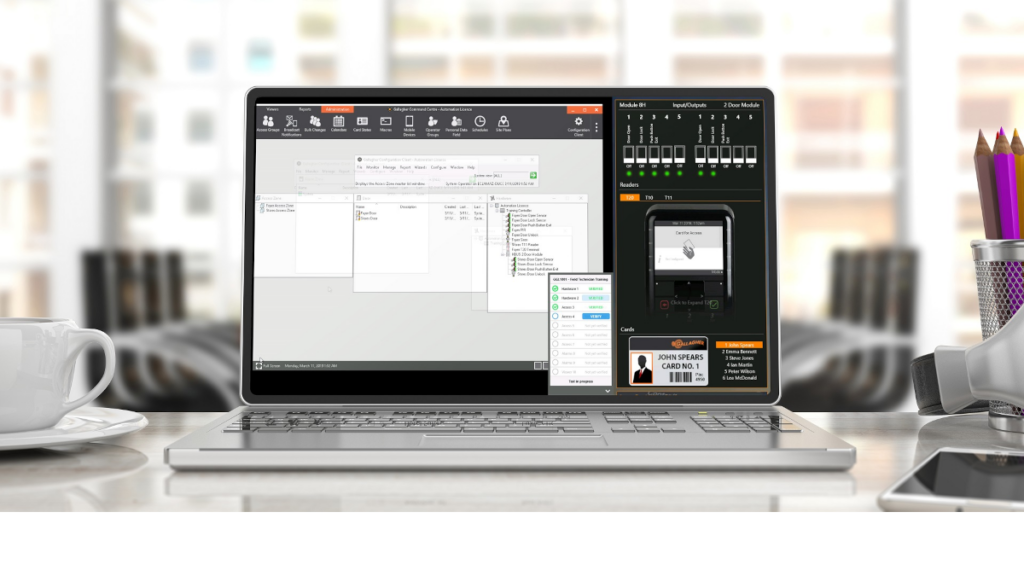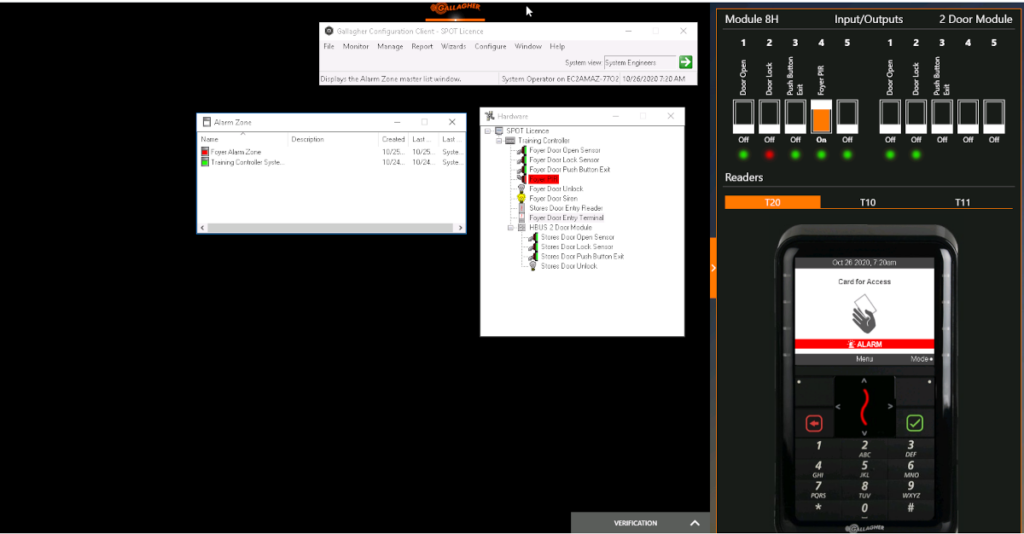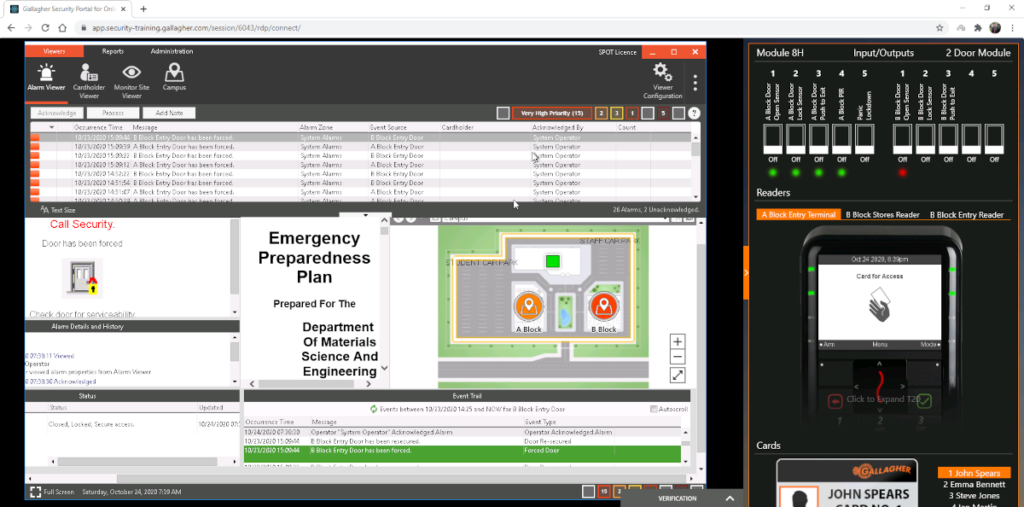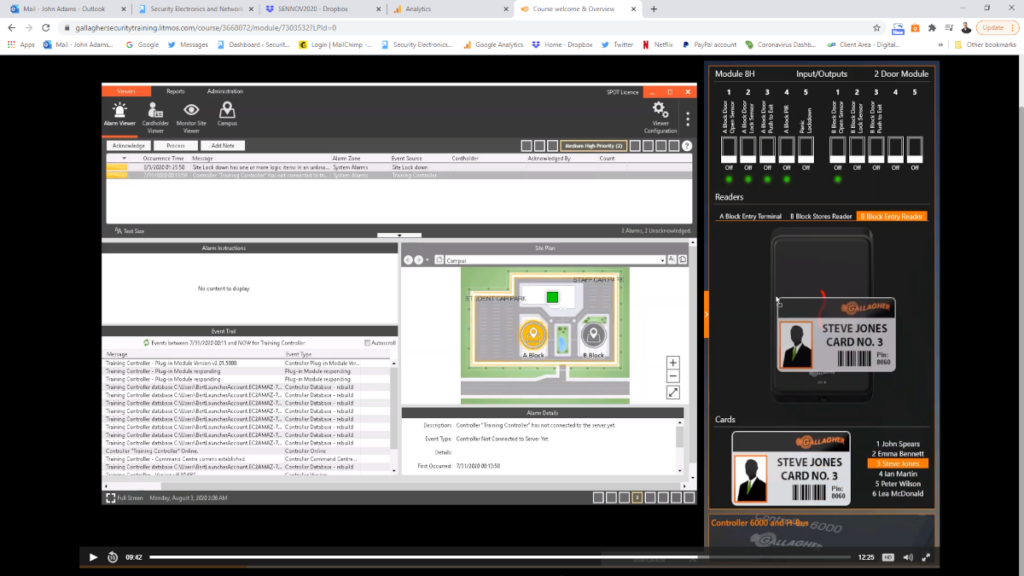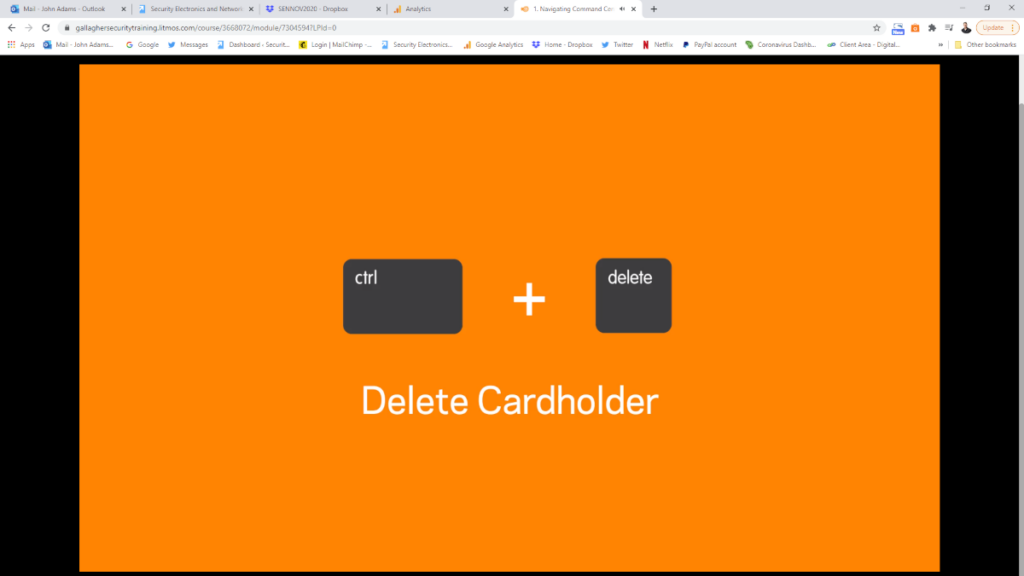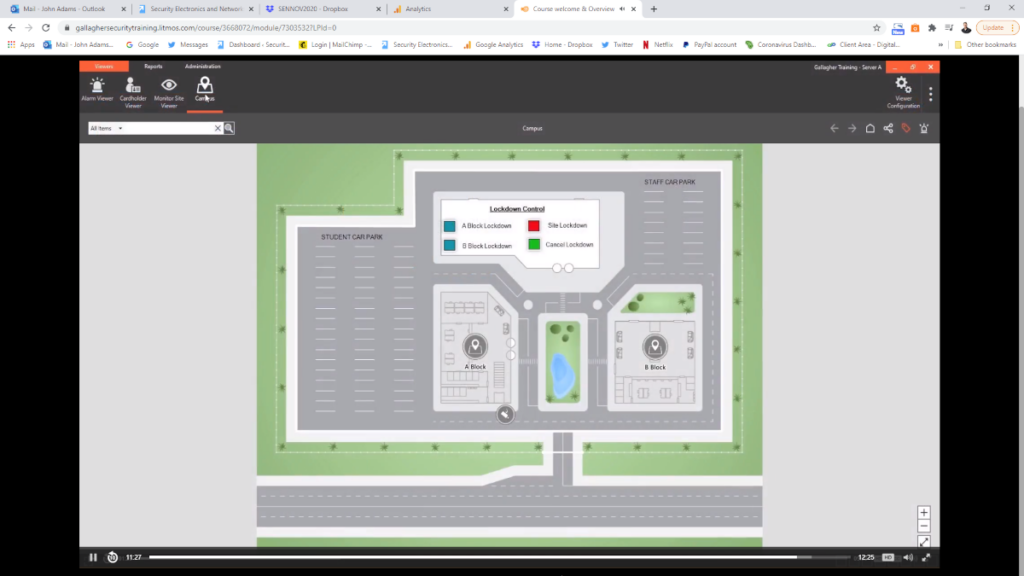Gallagher Operator Online Course Review
Contents
Gallagher’s Operator Online Course ushers users, operators, installers and integrators into the company’s security solution, building an understanding of viewer panels, toolboxes, cardholder management, contextual reporting, alarm management and effective use of site viewers hand-in-hand with a hardware simulator. It’s a conceptual integration that delivers learning with a real synthesis of software and hardware.
Gallagher Operator Online Course is an online environment the company developed and launched in 2019 to provide channel partners and end users certification and recertification. Built into the same cloud portal, the operator training course was launched in June this year for Gallagher end users. It goes without saying that 2020 has been a year of change, with global lockdowns restricting travel and changing the way people work – that applies to training as well.
Importantly, market acceptance of the course has been huge – there have been 5500 registrations through Gallagher’s online courses over the past 12 months and from September to the present, 2700 technicians and operators have completed the course and achieved certification – the equivalent of 160 classroom courses.
According to Gallagher Training Solutions’ Brendon Smith, there was an 18th month R&D process required to come up with the design of the online courses.
“All our courses are structured in a way so that there’s content that can be navigated through in a modular way that is easy to digest – we wanted to ensure a smooth customer journey from when they register, when they log in, to when they start absorbing course content, to when they start doing their certification and get their ID card and are qualified,” Smith said..
“We now have 3 cloud systems supporting our online training offer – the security portal for online training – it’s a global cloud and there are partners in 160 countries. This means we are able to get certification to countries to places we never could before – Nigeria, the Middle East, Russia, South America. The portal has given us reach and scale we just did not have with human trainers. An advantage for learners is that they don’t have to wait for the trainer to come, or for the kit to arrive. We will still run classroom-based training, but this gives us reach and scale – and does so economically.”
Because there is responsiveness and latency to consider, the courses are housed in 2 cloud locations – a data centre in Ohio in the U.S. for the Northern Hemisphere and another in Sydney, Australia, for the Southern Hemisphere.
“There are 100 virtual machines sitting in the data centre in Ohio and 100 machines in Sydney, so we can accommodate 200 students simultaneously working on the platform,” Smith says. “As they go through the course – we can see the student’s sessions and can tweak the sessions. We learn from what they get wrong and we can give them feedback on where they are going wrong. It’s a learning tool as well as an evaluation tool – better to get it wrong in training than on a customer’s site.”
“We do give a lot of videos but there’s also a workbook and we ask students to do it themselves – they have to go and perform some exercises and configure a solution on this virtual platform – there’s a verification tool – step 1 do this, step 2 do this, etc, to configure the exercise so they can check their work as they progress. We want people to have a practical engagement with the software because when people engage with the software, that’s when the learning happens.”
Sitting The Operator Course
Although I’d had a chat with Smith before I got stuck into Gallagher’s online operator course, I was a wee bit apprehensive about the density of information that might come my way. Software management solutions can be layered, I fretted. But this portal eases you in with simple introductory explanations, circling back to touch on key points a second, even a third time. It wasn’t long before I was very comfortable with the course modules. Almost as soon as I got into them it was clear that new operators would seriously benefit from having this resource at their elbows for reference at any time, saving them from reaching out to a supervisor or supplier.
Part of the comfort level comes from interacting with the software-based hardware simulation – you meet this during the introductory video and there’s a certain magic to being able to drive contacts to complete ‘hardware’ circuits on one side of the screen, while those same events are being reported in the software viewer alongside. Combining a sense of field and management components, Gallagher’s team has contrived to demystify the highly evolved Gallagher Command Centre management system through simple explanations of complex functions.
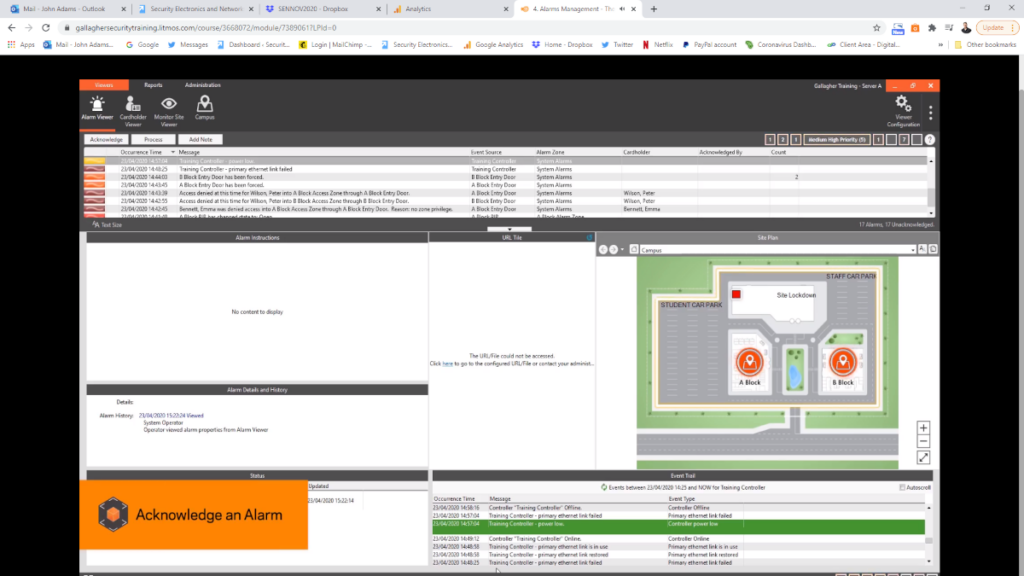
The core elements of the course are built around modules, which include Navigating Viewer Panels, Tile Toolboxes for Viewers, Cardholder Management, Mifare Card Assignment, Alarm Management, The Monitor Site Viewer, Reporting and Contextual Reporting. And the course concludes with that practical simulation, I mentioned, allowing students to undertake predetermined exercises in a safe training environment to enhance comprehension and develop their skills.
It starts off with navigating viewing panels. I sat down wondering how I was going to get on but the process of being led through system functionality was straightforward – a few points came and went that gave me pause to consider I’d need to revisit to commit them to memory, but the process was simple. In part, this is a testament to Gallagher Command Centre, which is a thoroughly mature product with any rough edges long smoothed away by the lapidary of updates based on customer experience.
Functions are accessed via viewers, including alarm viewer, cardholder viewer, monitor site viewer and campus, and key processes like tweaking cardholder information fall readily to hand via the cardholder viewer. While everything you might need to manage is front and centre, Command Centre is designed to allow you to minimise and maximise viewer functions you are not working on – this allows you to peel away complexity and focus on specifics like assignment of competency, assignment of access, all the while cardholder history and event trail fall readily to hand.
There are some shortcuts, too, including Delete Cardholder and log out, while typically fiddly aspects, such as creating a cardholder after first searching for potential duplicates, are all easy to achieve. Choices like assigning card type, adding an image, setting authorisation dates, adding PINs, adding personal data and assigning access rights from existing access authorisation levels are low touch and once it’s all done you can use broadcast notifications to send a message to the cardholder advising them their card is ready.
Next comes alarm viewer, which allows operators to manage alarm events – alarm event lines include icons to indicate to operators what’s going on – active alarm, escalated alarm, images of an alarm – you click on an alarm to get the event history and it’s also possible to call up a site plan showing the location of the sensor in alarm. This would be extremely useful in complex environments like hospitals.
Neat, too, you can scale the alarm event list up and down at the pull of a mouse if you don’t need additional information. The alarm viewer will display cardholder information related to an alarm event and there’s additional information shown for alarms like door open too long. Notes can be added to alarms, or authorisations can be tweaked to allow scope for legitimate operations that are causing alarm events.
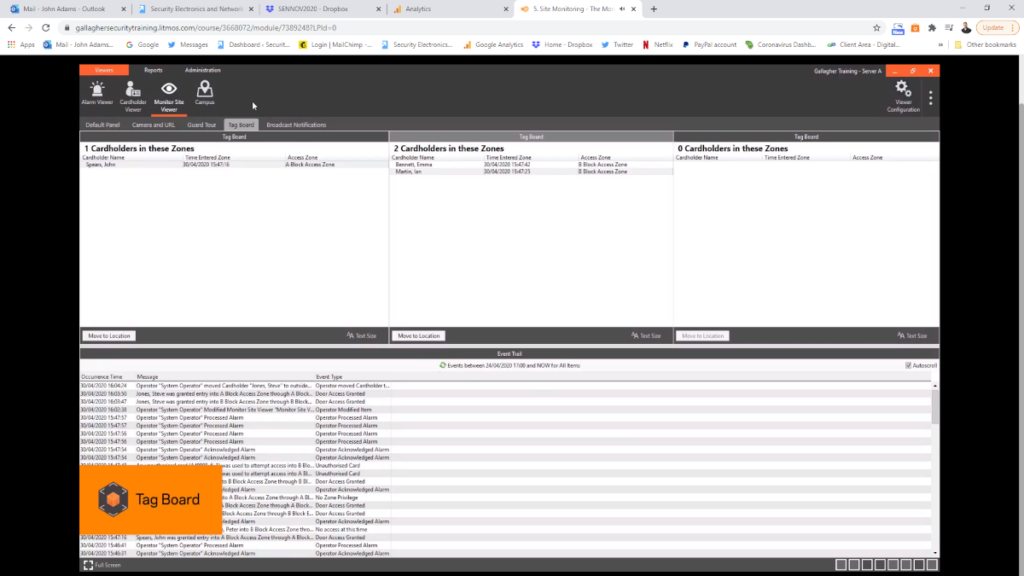
Monitor site viewer will show alarm events, event status of alarm events that have been resolved and there’s easy access to reporting. Monitor site viewer also allows access to camera views and documentation like an emergency preparedness plan can be slotted into the viewer. Another neat feature is tag board, which allows operators to establish who is in an area at a given time. And the reporting system is easy, too – you click through the report viewer and a list of reports is displayed including options like ‘Blocked Access’, ‘Today’s Alarms by Priority’ and ‘After Hours Cardholder Activity’. You select a report, click run and it’s done.
Another viewer function of interest is Campus – this where you drive global functionalities like site lockdowns – these are super simple, too. In the case of this training module there’s Building A Lockdown and Building B Lockdown, there’s also Site Lockdown and Cancel Lockdown. On more complex sites like education, defence or healthcare, there will be more of these options, but the functionality remains one-touch, which is important given operators will only drive them under conditions of extreme stress.
Hardware Simulation
According to Smith, like the training course, the hardware simulation is hosted in the Gallagher cloud.
“We wanted to make sure we had a secure solution – it had to be secure because it’s a live working copy of Command Centre and if you look at the virtual panel you can see there’s a door module here – it’s hardware that students doing the course can interact with,” he says. “This version of Command Centre will communicate with this virtual panel which we call the training simulator. As they practise in the software, they can see what’s happening with the hardware – badge a card, etc, it shows access granted – very interactive.
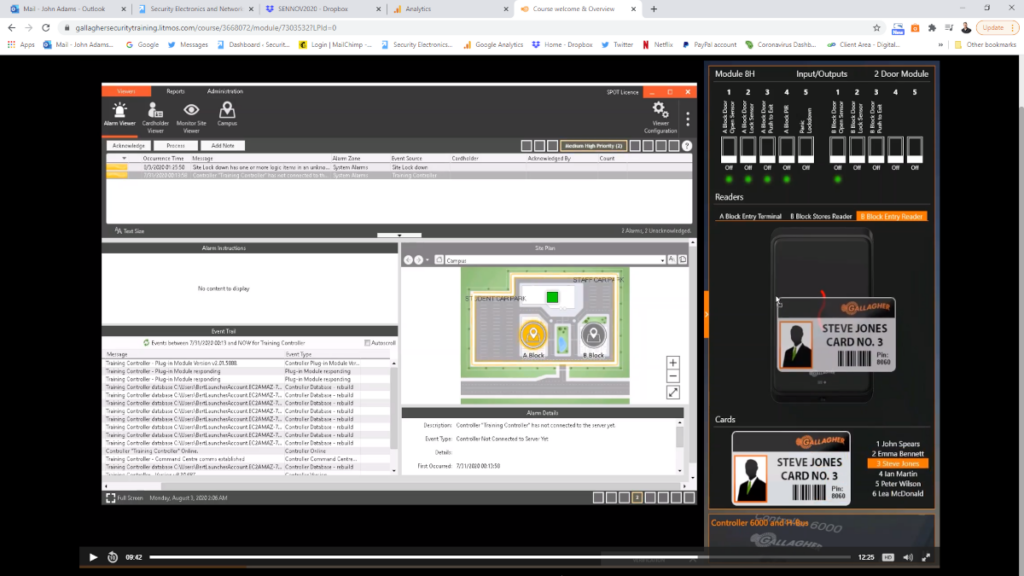
“If I force the door open for instance, I will get an alarm on the panel, I can look at the site plan, drill down and see what the alarm was, I can acknowledge the alarm – it’s a live working system, I can add some cardholders. There are various bits of functionality that the learner can go in and play around with and have a live working copy of the system. We can create different templates – this is the operator end user template – and we have tailored the content of each module to match what they need to learn.
“In the techs’ platform you can configure hardware, bring controllers online, programme controllers and do inputs and outputs – it’s the nuts and bolts of the system. As you build things, you can interact with them – so the value of the learning is high – having the software connecting to the hardware like this makes it so much easier to understand what’s happening in the system – when you have the 2 on screen together you can see the corresponding alarms and understand what’s going on.”
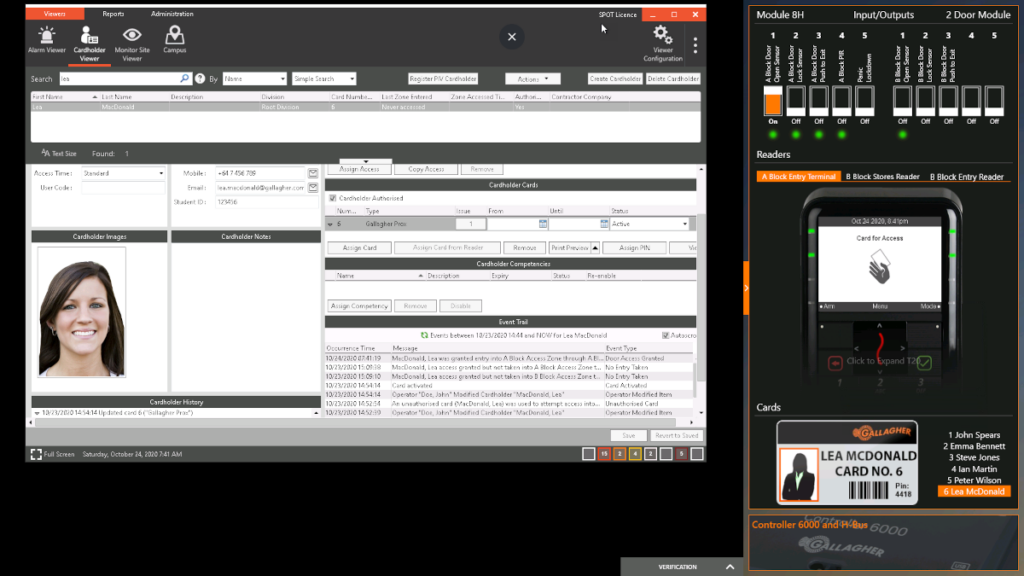
From the point of view of the student experience of the simulation, that’s exactly how it is, too. You build the system one piece at a time and can check the functionality of each component as it’s added and do so in multiple ways. At all times you can check if your creation is functional with the click of a button. There’s no doubt this is a great way to help students conceptualise field components during the training process, building in an intuition for the geography of controllers and the topology of systems that will pay off in the field.
One of the big challenges of building any complex electronic solution is holding it in your mind long enough to understand wider issues when troubleshooting, or when undertaking unexpected customisation of system design in the field due to inevitable but unforeseen circumstances. This Gallagher simulation pulls techs and operators forwards, giving them a sense of field experience it would otherwise take time to build.
Gallagher’s Operator Online Course is an excellent learning tool and its development perfectly meshes with the challenges of the times. Best of all it manages to deliver an holistic feel of a Gallagher system to students.
“We were aware that our audience learn by doing – they want to get their hands on the gear, they touch and feel – it’s a very important aspect of how technical people learn,” Smith says.
“We thought, how can you achieve this in an online environment? That recognition is why we have the practical component of practising and configuring what we are teaching using the online training simulator. We were trying to give technicians that practical exposure, which is exactly what they will need when they are bringing a Gallagher system online.”
There are more details about this online course here and you can also read more reviews and news articles from SEN news here.
“Gallagher’s Operator Online Course is an excellent learning tool and its development perfectly meshes with the challenges of the times. Best of all it manages to deliver an holistic feel of a Gallagher system to students”.





